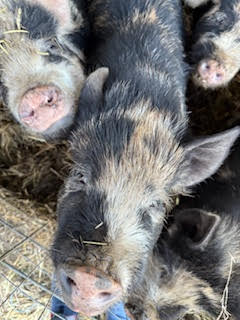Echo Valley Family Farm & Kune Kune Pigs
The choice to raise and sell Kune Kune pigs was a decision that was not made lightly. We have raised these awesome pigs for several years now and are amazed with their ability to adapt to their environment. As you will read in this blog, they are docile and friendly. They have been described as the ‘Wagyu” of pork due to their marbling and tenderness.
Here is a brief history of the Kune Lune Pig!
Introduction
Kune Kune pigs, affectionately known for their docile nature and distinctive appearance, have a fascinating history that spans centuries. Originating from New Zealand, these pigs have become a beloved breed among small farmers and pet enthusiasts worldwide.
Origins in Polynesia
The journey of the Kune Kune pig began in the islands of Polynesia, where they were initially bred by the indigenous people. “Kune Kune” translates to “fat and round” in the Maori language, aptly describing their physical characteristics. These pigs were an integral part of Polynesian culture, raised primarily for their meat and as a symbol of wealth and prosperity.
Introduction to New Zealand
The Kune Kune pigs were introduced to New Zealand by Polynesian settlers, who brought them along as they migrated across the vast Pacific Ocean. Once in New Zealand, the pigs adapted well to the local environment and became an important part of the Maori people’s agricultural practices. They thrived in the lush, temperate climate, which contributed to their distinctive traits and characteristics.
Physical Characteristics
Kune Kune pigs are easily recognizable by their short legs, round bodies, and dished faces. They have a unique set of wattles, or piri piri, hanging from their lower jaws, which adds to their charming appearance. Their coats come in various colors and patterns, including black, brown, white, and ginger, often with patches or spots.
Roles in Maori Culture
In Maori culture, Kune Kune pigs held significant cultural and social value. They were often given as gifts or used in traditional ceremonies, symbolizing goodwill and prosperity. The pigs were also a vital food source, providing meat that was highly valued for its flavor and tenderness.
Near Extinction
Despite their cultural importance and role in agriculture, Kune Kune pigs faced the threat of extinction in the mid-20th century. Changes in farming practices and the introduction of more commercially viable pig breeds led to a sharp decline in their population. By the 1970s, Kune Kune pigs had become exceedingly rare, with only a few small herds remaining in remote areas of New Zealand.
Rescue and Revival
The survival of the Kune Kune pigs can be attributed to the efforts of dedicated conservationists and breeders. In the 1980s, two wildlife park owners, Michael Willis and John Simister, recognized the breed’s perilous state and embarked on a mission to save them from extinction. They gathered the remaining pigs and started a breeding program aimed at increasing their numbers and preserving their genetic diversity.
Global Recognition
Thanks to the efforts of Willis and Simister, the Kune Kune pigs’ population began to recover. Their charming appearance, friendly disposition, and manageable size soon caught the attention of farmers and pet owners beyond New Zealand. The breed was introduced to the United Kingdom and the United States, where they gained popularity as both livestock and companion animals.
Modern-Day Kune Kune Pigs
Today, Kune Kune pigs are celebrated for their unique characteristics and gentle nature. They are commonly raised on small farms and homesteads, cherished for their easygoing temperament and minimal impact on the land. Their ability to graze on pasture, rather than relying solely on grain-based feed, makes them an attractive option for sustainable farming practices.
